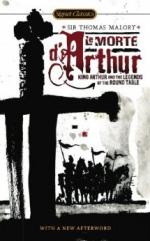|
This section contains 282 words (approx. 1 page at 400 words per page) |

|
Le Morte d'Arthur Summary & Study Guide Description
Le Morte d'Arthur Summary & Study Guide includes comprehensive information and analysis to help you understand the book. This study guide contains the following sections:
This detailed literature summary also contains Bibliography and a Free Quiz on Le Morte d'Arthur by Thomas Malory.
Although Le Morte d'Arthur is thought to have been written in 1469, the first known publication was in 1485, by William Caxton. Caxton's edition was divided into 21 books and 506 chapters. In 1934 another manuscript was discovered in the Fellows Library of Winchester College. The text of this second manuscript is more fully developed in sections than the earlier known edition and it is divided into ten parts, forming five larger sections. This later manuscript was published in 1947 as The Works of Sir Thomas Malory. This second text, with the divisions into five books, is the text most commonly used text today.
In composing this work, Malory took a body of legends, mostly French in origin, and adapted them to English life, with an English perspective. Malory's sources, dating from 1225-1230, are largely a selection of courtly romances about Launcelot. These stories purport to be historical accounts of King Arthur and his knights and of their quest for the Holy Grail. In addition to the French sources, Malory added material from a fourteenth century English alliterative poem, the Morte Arthur. Although it is probable that a real Arthur did exist (it is a common name), there is little actual historical basis for the stories, which are largely legend and folklore. Many scholars have attempted to prove the veracity of the work, but the attraction of Malory's work has always been the text itself, with its emphasis on courtly love, honor and virtue, valor and devotion, magic and miracles. Le Morte d'Arthur was immediately popular with readers and critics and has remained so. It has been an influential source for many writers, including Edmund Spenser's The Faerie Queene and Alfred Tennyson's Idylls of the King.
Read more from the Study Guide
|
This section contains 282 words (approx. 1 page at 400 words per page) |

|



